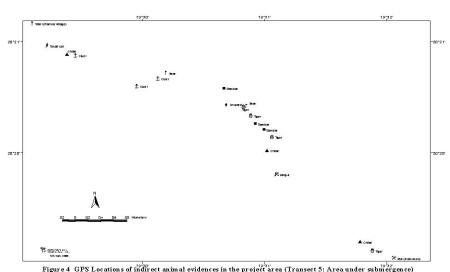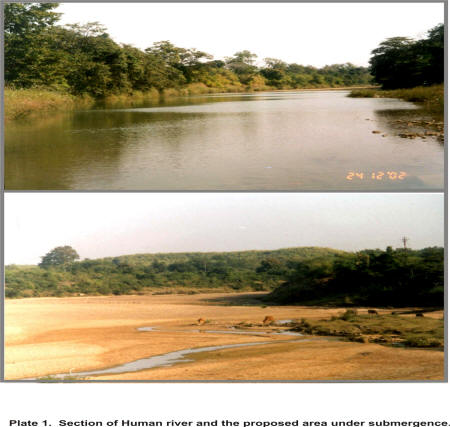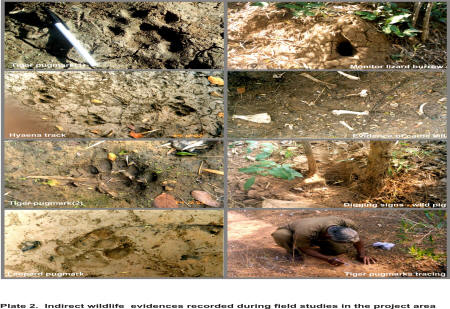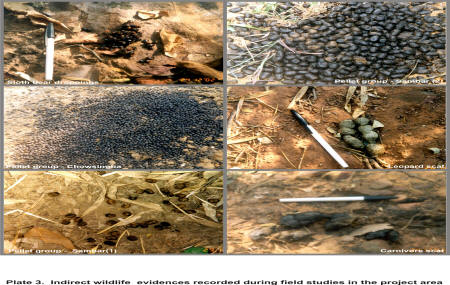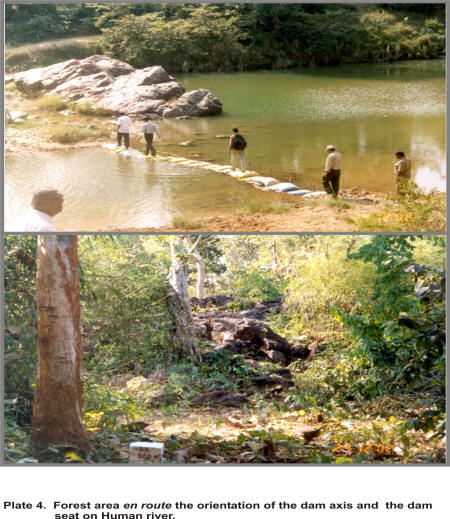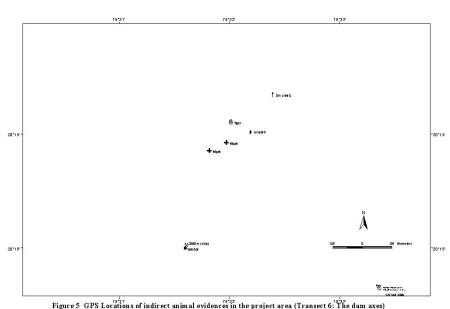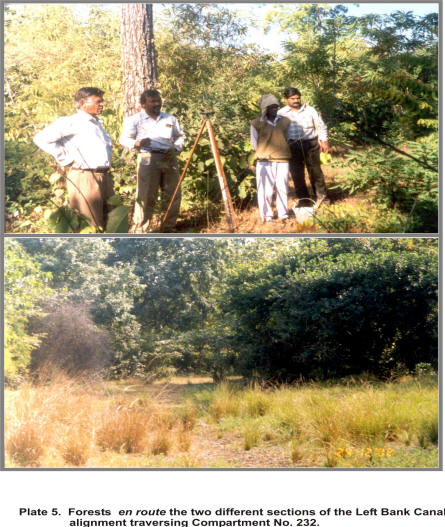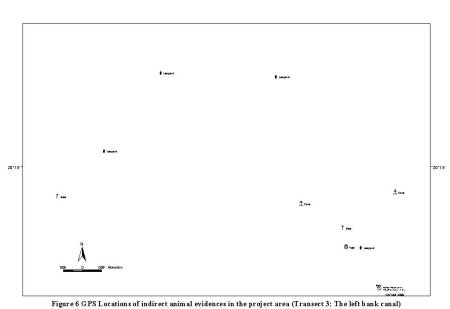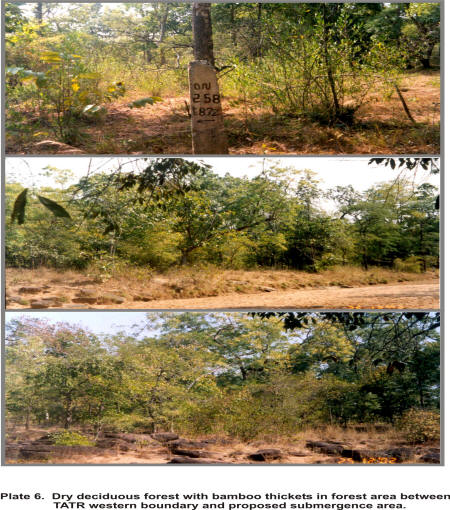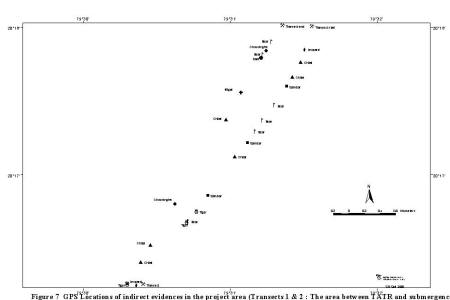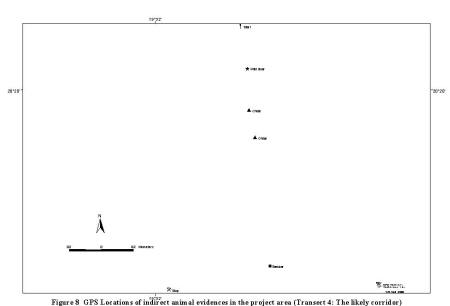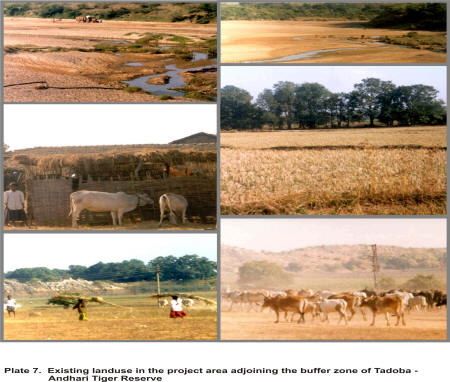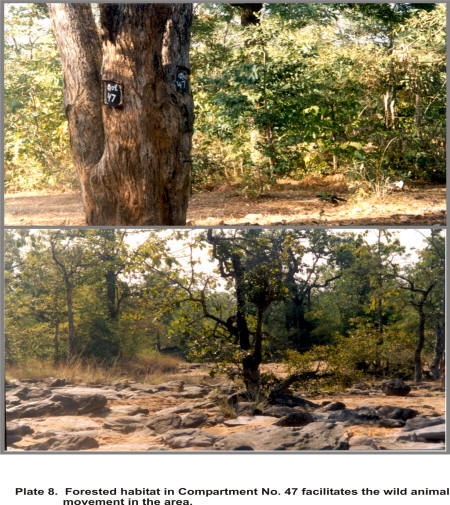Baseline studies
|
3.1 Introduction Although the scope of ecological baseline studies would vary from case to case depending on the wildlife groups to be surveyed efforts were made to structure these studies with due considerations to the duration of survey that would be commensurate with the scale of the proposed development at hand and review of Environmental Impact Assessment Ordinances and practice guidelines developed by professionals worldwide (Bagri and Vorhies 1997; Treweek 1999; Anon., undated). 3.2 An overview of the habitat 3.3 The status of habitat in the identified thrust areas Our assessment was largely confined to the western side of the Human river (towards the TATR), from the village Paarna to the dam site, while walking along the meandering river's curves and at times into the riverine forests.
Figure 4
Plate 1
Plate 2
Plate 3 Floral values Isolated patches of riverine vegetation along the Human river comprises mainly tree species such as Syzygium cumini, Terminalia arjuna, Ficus infectoria, and Mitragyna parvifolia (Plate 1). However, these riverine forests are conspicuous by the absence of representatives of old trees and the smaller patches are generally degraded due to intense human use and livestock grazing. The forests in this area are well wooded in parts with a crown density varying from 0.4 to 0.6. Faunal values The fauna of the area is typical of the landscape, which is largely dominated by agricultural fields, with patches of open scrub jungle, and riverine forests. Indirect evidences of ungulates (chital, sambar), sloth bear, large predators (tiger, leopard) and among small mammals, civets were recorded (Plate 2 & 3). The direct sightings of mammals included common langur (> 17 individuals) and a jungle cat (Table 8 & Figure 4). Among birds, the Grey Francolin, Rose-ringed Parakeet, Eurasian Collared-Dove, Indian Roller, Red-vented Bulbul, Indian Robin, Purple Sunbird, Common Myna, and Black Drongo were abundant. The riverine forests commonly reveal presence of ‘forest edge - secondary forest species’ like Shikra, Spotted Dove, Lesser Golden-backed Woodpecker, Common Woodshrike, Small Minivet, Common Iora, Tickell’s Blue Flycatcher, and White-browed Fantail Flycatcher among birds and Mabuya carinata and Calotes versicolor among reptiles. One of the most striking aspects of the birdlife here is the apparent paucity of raptors, despite the presence of a riverine ecosystem. In central India, forests along river courses are generally rich in raptor diversity. However, we encountered only three species of birds of prey viz., Black-shouldered Kite, Black Kite, and Shikra. Among reptiles, the area supported common and habitat generalist species like Varanus bengalnensis, Mabuya carinata, Calotes versicolor, Psammophilius dorsalis, and Sitana ponticeriana. The quality: structure, composition and integrity of riverine forests that arbiter presence of several raptor species like Changeable Hawk-Eagle, Crested Serpent Eagle, Bonelli’s Eagle or the wintering populations of Eurasian Sparrowhawk is lacking. The species diversity of waterbirds (including waders and waterfowl) is also very spectacular, while there were no records of turtles and crocodiles along the section of Human river surveyed. Anthropogenic pressures The forests are located in a mosaic of agriculture fields and villages (Zudpi areas or shrub lands) and are under intense anthropogenic pressure as evident from the sparse crown density of 0.2 – 0.5 (Anon., 2001) recorded from the forests neighboring villages. Several instances of wood cutting, water tapping for irrigation purposes and sand mining were recorded in this area. Heavy demands for water, to meet the irrigation needs of the small farmers dotted along the entire stretch of the river and the intensive use of the area by livestock was quite evident. The river itself is reduced to small pools and puddles of water in the dry season. Many of these pools are stagnant and polluted, and therefore are not suitable for supporting significant waterbird populations. 3.3.2 The forest area en route the dam axis Floral values The Reserved Forest through which the dam axis traverses is a mix of dense scrub jungle and dry deciduous forests (Plate 4). Commonly recorded plants of the area were Grewia hirsuta, Pterocarpus marsupium, Madhuca indica, Syzygium cumini, Mitragyna parvifolia, and and shrub layer dominated by Lantana camara. Tall trees typical of the central Indian highlands such as Tectona grandis, Terminalia tomentosa, or Dalbergia paniculata were very few in this area.
Plate 4
Faunal values Indirect evidences of ungulates (chital, sambar) sloth bear, large predators (tiger, leopard) and small omnivores like civets were recorded among mammals (Plate 2 & 3). The direct sightings of mammals included a troop (> 10 individuals) of common langur (Table 8 & Figure 5). No endemic or endangered species of birds and reptiles were recorded. The area supported common species of reptiles like Varanus bengalnensis, Mabuya carinata, Calotes versicolor, Psammophilius dorsalis, and Sitana ponticeriana. Anthropogenic pressures Although, no villages are located along the orientation of the dam axis, the area is adjoins villages and therefore signs of woodcutting and grazing were commonly observed. The dam axis also cuts across a highway, which would be re-aligned during the Project implementation phase. 3.3.3 The forest area under Left Bank Canal Floral values The area is largely scrub forest dominated by Lantana camara, Zizyphus oenoplia, and Grewia hirsuta. Here again tall tree species like Tectona grandis Terminalia tomentosa, Anogeisus latifolia and Dalbergia paniculata are almost absent leading to significantly reduced diversity of the forests. Faunal values Indirect evidences of ungulates (chital, sambar, nilgai and chowsingha), large carnivores (tiger, leopard), jackals, hyaena, hare, porcupine and civet were recorded among mammals (Plate 2 & 3). The direct sightings included common langurs (Table 8 & Figure 6). The bird community in this habitat is dominated by generalists species like Rose-ringed Parakeet, Purple Sunbird, Red-vented Bulbul, Spotted Dove, Greenish Warbler, and Yellow-throated Sparrows. Reptiles in the area are also represented by habitat generalists species like Calotes versicolor, while no rare and endangered species were recorded. Anthropogenic pressures Signs of wood cutting and grazing though not common were occasionally seen. 3.3.4 The area between the TATR and submergence The forests in the submergence zone are a mix of dry deciduous and scrub with an average canopy height of 5 m. The more commonly observed species were Zizyphus oenoplia, Anogeisus latifolia and Grewia hirsuta. Some patches are completely degraded and naturally open with rocky outcrops. Towards the western side (the TATR boundary) the forests gradually change in structure and become denser with well defined bamboo understorey. Trees like Dalbergia paniculata, Tectona grandis, and Terminalia tomentosa were also recorded here (Plate 6). Faunal values Indirect evidences of ungulates (chital, sambar), sloth bear, hyaena, large predators (tiger, leopards) and small mammals like civets were recorded (Plate 2 & 3). We also recorded occasional evidences of nilgai and chowsingha Direct sightings involved a troupe of common langur (Table 8 & Figure 7). Among reptiles, the area supports common species like Varanus bengalnensis, Mabuya carinata, Calotes versicolor, and Sitana ponticeriana. No endemic or endangered species were recorded.
Figure 5
Plate 5
Figure 6
Plate 6 Anthropogenic pressures The area is dominated with agriculture fields interspersed with forest patches and many villages such as Sirkada, Vihirgaon, Piparda, Parna, Palasgaon and Gondmohadi. Intense pressure for fuel wood and livestock grazing (Plate 7) lopping and the movement of livestock, are persistent and significant sources of intense biotic pressures. 3.3.5 The likely corridor for animal movement Floral values The terrain is undulating with well wooded forests, dominated by Tectona grandis, Chloroxylon swietenia, Miliusa velutina, Anogeisus latifolia, and Terminalia sp. on drier sites and Boswellia serrata. The shrub layer is dominated by Lantana camara (Plate 8). Faunal values Indirect evidences of ungulates such as chital, chowsingha, sambar and wild pig were recorded (Plate 2 & 3). The direct sightings of mammals included a troupe of common langur (Table 8 & Figure 8). Though the bird life was not as diverse as that of the adjacent Protected Area (Tadoba-Andhari Tiger Reserve), it was marginally richer in species composition than the avifauna near Human river. Presence of birds such as Large-tailed Nightjar, Grey Junglefowl, Red Spurfowl, Black-backed Woodpecker, and Brown-capped Pygmy Woodpecker indicate greater diversity of habitat elements. There is an opportunity to manage such areas for larger generalists and versatile species of large carnivores and their prey as the evidence of diverse components are indicative of lower disturbance. Anthropogenic pressures Although there are no villages in this area, there is still pressure on this habitat in form of illicit cutting of wood and livestock grazing as the area adjoins villages. This is not an uncommon situation in Indian forests by any means, PA’s notwithstanding. 3.4 Avifaunal assessment of conservation significance in the Project area The birds of central Indian forests, though not as rich and remarkable as that of Eastern Himalayas or Western Ghats, do comprise a few species of conservation significance at the national and global levels. These include Indian White-backed Vulture, Malabar Pied Hornbill, Forest Owlet, Spotted Grey Creeper, Green Munia, and White-bellied Minivet. We did not encounter any direct or indirect evidences of the presence of these birds in our rapid survey of the areas under the proposed Human River Project. The submergence area of the Project was also not found to have any significant patch of potential habitats for these threatened bird species. During the survey, many species of birds have been recorded and presented in Table 10. The lists of mammals, birds and reptiles recorded in the different trust areas have been complied and presented in Tables 9, 10 & 11.
Figure 7
Figure 8
Plate 7
Plate 8 Table 8. Summary of mammal evidences during transect sampling
Table 9. Mammals recorded from the Proposed Project site
Table 10. Birds recorded from the Proposed Project site (Taxonomy followed: Manakadan & Pittie, 2001)
Table 11. Reptiles recorded from the proposed Project site (Taxonomy followed: Das, 1997)
|
Last Updated: October 3, 2015


